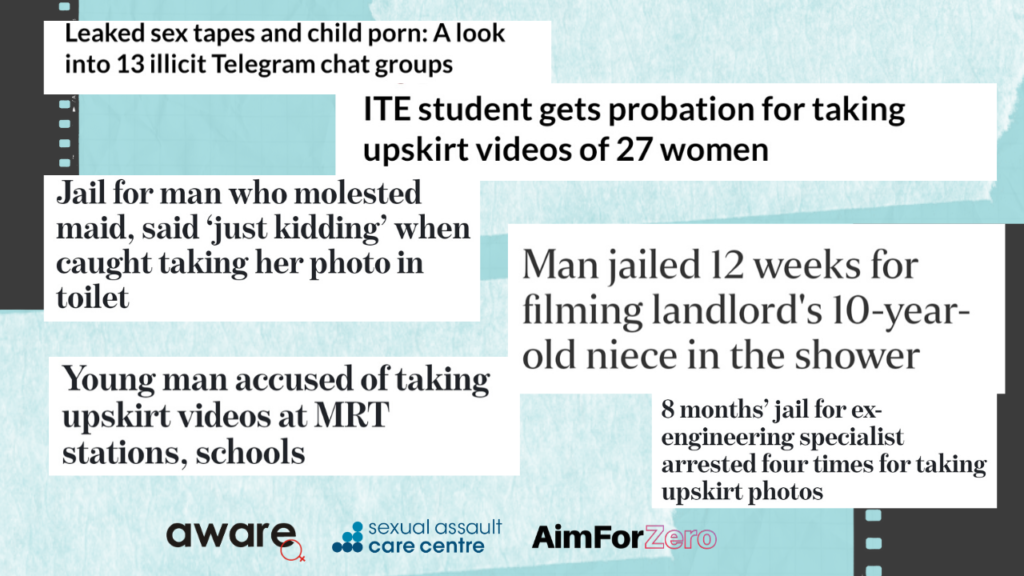What is technology-facilitated sexual violence?
Technology-facilitated sexual violence (TFSV) is enabled by digital communications technology, such as social media and messaging platforms, digital cameras and dating apps. These actions range from unwanted and explicit sexual messages and calls (including attempts to coerce sex or a relationship), to a category that we refer to as image-based sexual abuse.
Image-based sexual abuse (IBSA) is the non-consensual creation, obtainment and/or distribution of sexual images or videos of another person. It also includes threats to carry out the above. These images can be so-called “nudes” taken with the subject’s consent as well as images taken without the subject’s knowledge (e.g. via “upskirting” and placing hidden cameras in public places). In Singapore, IBSA cases have made headlines with frequency of late.

TFSV cases seen by SACC have been on the rise: from 46 in 2016 (out of 338 total cases), to 99 in 2017 (out of 515 total cases) and 124 in 2018 (out of 808 total cases). IBSA cases seen by SACC doubled over the three years, from 30 in 2016 to 64 in 2018. Read more of our 2016-2018 statistics here.
TFSV can be committed by anyone: acquaintances, family members, colleagues, intimate partners or even strangers. Perpetrator profiles, where known, cut across age, class, educational background and race. Almost half of IBSA cases seen from 2016-2018 were committed by an intimate partner. On the other hand, perpetrators of unwanted or explicit communication were likely to be someone in the survivor’s workplace.
What to do if you experience TFSV
First, ensure your own physical and emotional safety. If possible, take photos or screenshots to gather evidence of the act. You may want to tell someone that you trust about what happened.
It is your choice how you would like to proceed. You may wish to:
a) Alert the relevant authorities (e.g. the police, school officials)
b) Reach out to SACC for support on the specific situation. SACC will explore your options with you, and can accompany you to make a police report or apply for court orders under the Protection from Harassment Act to stop the materials from being posted. Refer to this page for more information about our services and what to expect when you reach out to our centre.
c) Explore some options on Solid Ground, a website co-developed by AWARE that offers step-by-step advice for anyone in Singapore experiencing nine different types of online harassment.
Can I file a police report for TFSV without knowing who the perpetrator is?
Yes. The police would attempt to find out who the perpetrator is. You would not be able to file a protection order against an unknown person. However, you would still be able to apply for a non-publication order, which would be served to websites (though this would be limited by jurisdiction).
What can a bystander do if they come across an instance of TFSV online?
You should not further the distribution of the images or messages. Call your friends out for sharing such pictures and videos. You could report the images or messages to the administrator of the online platform, as well as speak out about their inappropriateness (e.g. in comments, etc). If you know the survivor, you could let her or him know about what you have come across. Make sure to validate the survivor’s feelings and experiences without judgment or prescription of any one course of action.
Other Frequently Asked Questions
Is TFSV less “serious” than physical forms of sexual violence, such as assault?
The impact of TFSV is sometimes thought to be less “real”, compared to physical forms of sexual violence. However, a survivor’s shame and loss of control may in fact be amplified in TFSV cases, because of how hard it is to fully eradicate a piece of content from the internet when it has been shared.
Should women avoid online spaces where they are likely to face TFSV?
The responsibility of preventing TFSV should not be placed on women. After all, technology is a big part of how we work, live, communicate and sustain relationships—in this day and age, it is simply unrealistic to expect women to withdraw from the digital world. Instead, we need to work towards building healthier relationships, greater gender equality and an overall respect for an individual’s consent and agency.
What is “revenge porn” and why do some avoid using this term?
Non-consensually shared intimate photos (e.g. “nudes” that were willingly shared by one partner to another, but later disseminated online by the latter) are sometimes referred to colloquially as “revenge porn”. However, many experts find this term inaccurate and misleading. “Revenge” implies some sort of initial wrong-doing that necessitates retaliation, while “porn” is content produced with very specific (i.e. public) distribution intentions. Neither of those is the case when perpetrators violate women’s privacy and consent by sharing images meant for their eyes only.

